A Timeline of the Geoscience Department
A University Sesquicentennial Project (1999), by R.H. Dott, Jr.
The following highlights were selected from The History of Geology and Geophysics at University of Wisconsin–Madison, 1848–1980, (S.W. Bailey, Editor, published by the department, 1983) and from other records for the post-1980 period. Dedicated to the memory of Professor S.W. Bailey and his uncommon devotion to both his university and his department.
1853–62
First geological surveys of Wisconsin were led by Edward Daniels (1853–54), James G. Percival (1854–56), and then by three commissioners, James Hall, Ezra S. Carr, and Edward Daniels (1857–62).
1856
First geology instruction. Ezra Carr, Professor of Chemistry and Natural History, began teaching chemistry, geology, and botany. Student John Muir reported that Carr’s demonstration experiments rarely worked.
-
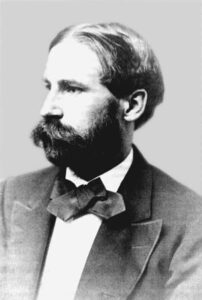
Roland D. Irving
1870
First Professor of Geology. Roland D. Irving, a new graduate of the Columbia University School of Mines, was appointed Professor of Geology, Mining, and Metallurgy. He quickly became a faculty leader and was one of the first Wisconsin faculty members to achieve national stature.
1873–82
A new geological survey of the state was authorized with respected naturalist Increase A. Lapham as director. After an untimely death, Lapham was succeeded first by O.W. Wight (1875) and then T.C. Chamberlin (1876–82). R.D. Irving, C.R. Van Hise, and several others worked as part-time assistants on this survey. The resulting four-volume report and folio of maps matched in quality the best surveys in America or Europe, and launched Chamberlin’s distinguished career as scientist and administrator.
1877
The first Science Hall was completed.
1878
Department of Geology and Mineralogy. A separate department was created with Roland D. Irving as its head. Charles R. Van Hise was retained as an instructor after his graduation in 1880. The two of them taught all of the courses.
1882
First advanced degrees. Charles R. Van Hise and Magnus Swenson (Agricultural Experiment Station) received Master of Science degrees, the first research degrees ever awarded by the university.
1882
Federal survey branch office. R.D. Irving was appointed chief of the Lake Superior Division of the U.S. Geological Survey, which was based at the university. Its mission was to study all aspects of the geology of the iron-ore-bearing Precambrian rocks of the region. Irving thus became, at the same time, a faculty member and a federal employee.
1884
First Science Hall destroyed by fire. Besides the loss of much scientific apparatus and important documents, museum collections of minerals, fossils, and works of art were destroyed.
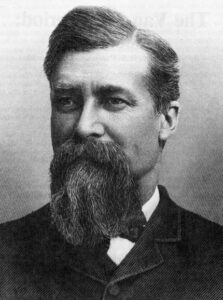
1887–92
First geologist president. Thomas Chrowder Chamberlin, as president of the university, expanded the faculty, instituted reforms such as increasing the role of science in the curriculum and formalizing graduate study. He created the University Extension program in 1892, thus laying the foundation for the “Wisconsin Idea.” Besides his importance as administrator, Chamberlin also was prominent in the study of glacial geology, which he introduced to the program of the Department of Geology. In 1881 he had been appointed chief of the U.S. Geological Survey’s Glacial Geology Division, which position he retained even while president. In 1885, he published a classic paper on artesian wells. In 1892, he accepted the challenge of establishing a Department of Geology and the Journal of Geology in the new University of Chicago. His continuing glacial research led him to theorize about the climate, the atmosphere, and the origin of the planets.
-
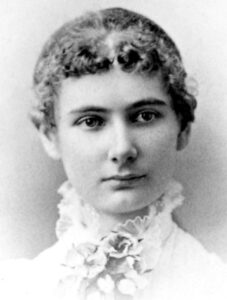
Florence Bascom
1887
Florence Bascom, daughter of President Bascom, received the second M.S. degree awarded by the Department of Geology and Mineralogy. Florence then completed her Ph.D. at the Johns Hopkins University, established a reputable geology program at Bryn Mawr College, and pursued a distinguished research career. In 1894, Florence became the second female member of the Geological Society of America.
1888
The Van Hise Era. Upon the sudden death of R.D. Irving, C.R. Van Hise inherited both of his mentor’s positions, chairman of the Department of Mineralogy and Geology, and chief of the Lake Superior Division of the U.S. Geological Survey.
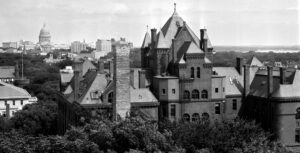
1888
The second Science Hall (still extant) was completed with its unprecedented “fireproof” construction with steel I-beams, inner walls and ceilings of hollow tile, exterior walls of brick and stone (rhyolite), and a slate roof. While Physics, Engineering, and Biology (most memorably, Anatomy) gradually moved to other quarters, Geology remained for 87 years. Geography and miscellaneous program offices occupy it today. In 1920, a UW English professor wrote: “The largest, most useful, most expensive, and easily the ugliest building the university had acquired, Science Hall will doubtless stand indefinitely, as a monument to the prosperity, progressiveness, bad taste, and good intentions of the latter eighties.”
1892
First Ph.D. awarded. Charles R. Van Hise, who ten years earlier had received one of the first two M.S. degrees awarded by the university, now became its first Ph.D. recipient. This man of “firsts” was destined also to be the first Wisconsin graduate to be named president (1903).
1893
Expansion of the geology faculty. The faculty now consisted of C.R. Van Hise (Chair), W.H. Hobbs, R.D. Salisbury, and J.M. Clements.
1897
Permanent Geological and Natural History Survey. The legislature established a permanent survey with Professor E.A. Birge as its first director (initially with no salary). In 1908, William O. Hotchkiss became director and state geologist. His tenure lasted until 1926, during which time many students and some faculty of the Department of Geology conducted summer field work for the survey, which provided a mutually important symbiosis between the department and the survey.
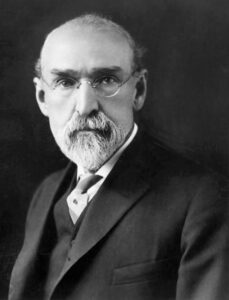
1903
Second geologist president. Under the guidance of C.R. Van Hise, the entire university expanded greatly its faculty, physical plant, and scholarship. A new emphasis, given to both research and extension education, was reflected in Van Hise’s famous declaration that “The boundaries of the campus are the boundaries of the state.” This “Wisconsin Idea” helped elevate the university to national and international stature.